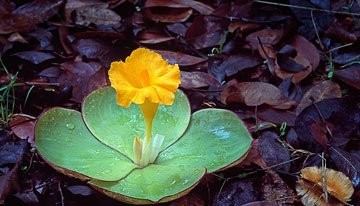
THE COSTUS SPECTABILIS
In honour of our upcoming Independence celebrations, Rock Solid looks at our National symbols during this month of October and very fondly wishes everyone a wonderful Independence Day and month. May we continue to live in peace and unity and enjoy progress, no matter the issues that we are grappling with.
PART ONE OF OUR NATIONAL SYMBOLS: THE COSTUS SPECTABILIS
The Costus Spectabilis is an African herb; low and perennial, it is found from Sierra Leone to Sudan to as far south as Angola and Zimbabwe, in other words, it is largely found almost all over sub-Saharan Africa. It is one of some 109 species belonging to the family of Costaceae, all tropical and occurring in Asia, Africa, Australia and the Americas. Closely related to the Ginger family, their underground storage organs are rhizomes, and they are largely shade-loving, with some species able to grow in full sunlight. They prefer moist soil and a humid climate. The flowers are showy, yellow, open singly and die rapidly, but are immediately followed by another. The leaves are quite succulent and are ringed with a deep purple, thus giving the plant a ‘water lily’ look. It is found in wooded grassland and deciduous woodland, occasionally near termite mounds or around rocks. Flowers are bright yellow with a crisped margin, and some 9 cm across and resembling those of a pumpkin. The texture of the flower is soft and thin.
Documentation of this gorgeous rhizome was first done by two botanists, first Eduard Fenzl (1808, Krummnußbaum – 1879, Vienna) an Austrian. He was Professor of Botany and Director of the Imperial Botanical Cabinet, a member of the Vienna Academy of Sciences and Vice-President of the Vienna Horticultural Society and secondly, Karl Moritz Schumann (1851, Gorlitz - 1904, Berlin) was a German. Dr. Schumann was the curator of the Botanisches Museum in Berlin-Dahlem from 1880 until 1894. He also served as the first chairman of the Deutsche Kakteen-Gesellschaft (German Cactus Society) which he founded on November 6th, 1892.
The Costus Spectabilis is our National flower; it appears on our Coat of Arms at the base of the shield on a bed of green grass. With all the documentation of the Costus Spectabilis that abounds, it is a wonder that we cannot accurately depict it with its glorious yellow beauty over 50 years after independence. Till date, it is erroneously depicted as a red flower. How and why this error came about and why our government has been unable to correct this anomaly is anyone’s guess. It can be found around the world in gardens and botanical centres featuring tropical plants, but does not seem to be cultivated here in Nigeria, not even officially as the National flower. The colour yellow, as the color of sunlight, is commonly associated with warmth.
As the color of light, yellow is also associated with knowledge and wisdom. In English and many other languages, "brilliant" and "bright" mean intelligent. In Islam, the yellow color of gold symbolizes wisdom. In medieval European symbolism, yellow symbolized reason. In many European universities, yellow gowns and caps are worn by members of the faculty of physical and natural sciences, as yellow is the color of reason and research. Yellow is also said to be the color of ambivalence and contradiction; the color is associated with optimism and amusement; but also with betrayal, duplicity, and jealousy. But in China and other parts of Asia, yellow is a color of virtue and nobility. For some, yellow depicts happiness, joy, leisure, enjoyment; for others, cowardice, exclusion and sickness. So as with all colours, its symbolism has both positive and negative sides.
As our National flower, we hardly know anything about it. It would be desirous to see it planted in our parks and gardens and be used in decorations of National and State government functions. As with all our National symbols, we should celebrate this most unique flower as it is part of our heritage as a nation.
Owner, TZADDI OIL & GAS (LAW & ENERGY FINANCE)
8yThanks! I had no idea Nigeria had a National Flower! I do now!
Administrator at La Roche Leadership Foundation.
8yThank you Prof. Emeagwali for your observation. I wouldn't be surprised if it is discovered that the Costus Spectabilis does have some medicinal value. It is after all, a member of the Ginger family, which is a medicinal plant and highly regarded in Ayurvedic medicine. If you get any more information, please consider sharing with us at the LinkedIn Community, I'm sure some would be delighted to know.
Gloria Emeagwali
8yThanks for this article. May I add that we need also to do phytochemical tests on the plant to determine its active ingredients. It could be the next cure for cancer. When visiting Beijing about a decade ago I was struck by the extensive use of petals of all types, including roses and hibiscus, for tea. Since then, I have learnt that the petals of hibiscus have been lab tested and found effective for hypertension. BTW yellow is sometimes a marker for Vitamin A. Now, let me concede that this could well be a poisonous plant so disregard until we have those phytochemical tests.